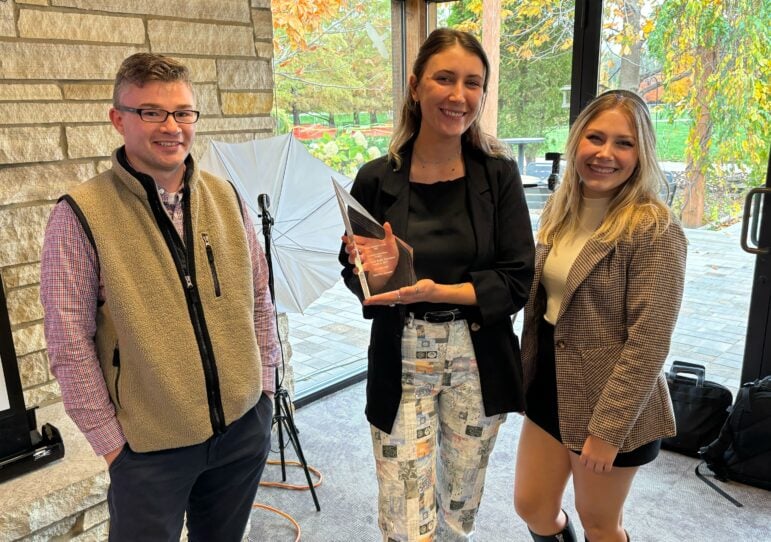How stations are using email newsletters to grow audiences and connect with communities

Mike Janssen, created with DALL-E 3
How many email newsletters do you subscribe to? According to 2021 research, 47.3% of U.S. adults receive at least one news and entertainment newsletter. With daily, weekly and on-demand options, public media is getting in on the act.
When done well, these newsletters reach new members, create an alternative distribution channel for journalism, uncover audience data and build a closer connection with audiences. But what makes a great newsletter and how to attract subscribers are vital questions that require testing to answer.
For Iowa Public Radio, newsletters offer a direct way to communicate with people. “You have their email and often their name,” says newsletter product manager Madeleine King. “With broadcasting, you are often staring into the void.”
IPR’s Daily Digest newsletter launched in March 2020, starting as bullet points listing public health officials’ statements about COVID-19. The newsletter expanded to cover other news with feedback suggesting subscribers valued it as a service. Each email includes at least one piece of good news, a feature titled “The Sunny Side.”
IPR now runs five award-winning editorial newsletters, from Political Sense, which focuses on local lawmakers, to Garden Variety, a community newsletter for gardening advice.
“The power of our newsletters is finding where the beats we own and our audience needs meet,” says King.
Creating a separate product
A weekly music newsletter, All Access, shares a beat with IPR’s All Access show, and the host of the Garden Variety program writes the introduction to its newsletter. But shows and newsletters are viewed as their own products, says King: “You get something different no matter what you engage with.”

David McGowan, CEO of WJCT Public Media in Jacksonville, Fla., agrees that newsletters benefit from being treated as separate products, not just as promotional channels for existing shows or brands. Run this way, they can help build a loyal subscriber base — a crucial element for a sustainable local news business model, according to WJCT’s research.
The award-winning Jacksonville Today newsletter was the first product launched under the Jacksonville Today brand, a separate local news service run by WJCT. It has more than 20,000 subscribers and highlights reporting from other local media in addition to Jacksonville Today’s own reporting.
“From a business standpoint, newsletters give you a set of email addresses and allow you to address your audience for those services directly,” says McGowan. “But from our experience, it’s important not to just do things that are self-promotional.”
“Newsletters move you to a place where we have more information about you, where you become a more regular or loyal user,” adds Gabrielle Jones, VP of content at Louisville Public Media.
LPM runs seven newsletters, including original content to provide a different experience even if they correspond to an on-air brand or station. Three biweekly newsletters also market membership perks, with members and donors seeing a different version of the email than noncontributors.
When to launch
Before launching a newsletter, LPM’s Jones challenges people to think about its purpose and unique value proposition. She evaluates whether other products “in the community” already do this job and if a new newsletter would add value.
“Our culture right now isn’t to pop up a discrete newsletter for a discrete product — the purpose is to meet people where they are,” she says. “We need to demonstrate that the target audience has this need.”
Evidence for or against a newsletter being the right product for a target audience may come from focus groups or audience surveys, but community feedback and “conventional wisdom” about audience behavior are important, she adds.

IPR’s King checks ideas for high-frequency newsletters against what reporters are consistently covering: “You don’t want to commit to a weekly newsletter and not have weekly content.” What’s being engaged with on IPR’s social media and website can also prompt ideas for newsletter products.
At St. Louis Public Radio, a proposal checklist helps the digital team stress-test newsletter ideas. The goal of the newsletter needs to be defined and questions answered about how it will work operationally, from the content schedule and proposed template to who would manage and write it.
In October, STLPR Engagement Editor Lara Hamdan launched a different kind of newsletter: the STL Welcome Kit. It’s a limited-series email, where a new subscription triggers the first of eight weekly newsletters introducing a different aspect of life in St. Louis.
“Our goal is to involve ourselves in newcomers’ media consumption early on, so they see St. Louis Public Radio as a brand and as their main resource for their news,” she explains.
The newsletter includes a weekly challenge to subscribers — including a design-your-own “I Voted” sticker for the edition on St. Louis’ political landscape — and a conversational, personal tone complete with a sign-off from Hamdan.
Tone and structure
A single person authoring a newsletter helps build an identifiable tone of voice for the product and a stronger relationship with subscribers, according to the experts we interviewed. Include pictures, adds LPM’s Jones: “People are talking to a person; they want to see who that person is.”
If a single author or owner isn’t feasible (perhaps multiple reporters produce the newsletter), add regular features to the format that reflect the contributors’ different personalities. A Daily Diversion feature at the end of LPM’s Daily News newsletter showcases the different voices of the editors who produce the email.

STLPR changed the tone and format of its weekly Off Mic newsletter. It now reads as a note from Elaine Cha, host of the corresponding St. Louis on the Air talk show, including behind-the-scenes insights. Readers find it more personal and respond with ideas for future on-air shows, says Hamdan.
The tone of your newsletter should also reflect when subscribers receive it. For example, King says, IPR’s weekend Chatter newsletter is more fun and playful than its weekday counterpart, for example. How and where subscribers will consume the newsletter should also inform its structure and length, she adds, explaining that IPR’s newsletters are a five-minute read on average: “You are probably reaching people on their phones, and they don’t have a lot of time in their day.”
Several of STLPR’s newsletters focus on building an engaged community of readers that can directly contribute to the station’s journalism. A format point of its daily and weekly local news Gateway newsletters is a “Tell us” question that subscribers can respond to. “Reporters can incorporate responses into reporting, and our talk show incorporates a lot of listener feedback,” says Hamdan.
Measuring success and growing subscribers
At LPM, Jones monitors multiple data points to assess newsletters against their goals. Consistency of newsletter referrals to the station’s website and the overall growth of subscriber lists are two key factors, she says.

“Newsletters are key to our overall growth strategy,” Jones says. “Like many public media stations, the challenge right now isn’t retaining donors or getting people in our system to invest more, but getting new members.”
Jones says she is less concerned with open rates — how many subscribers open each newsletter — but has used this data to inform a decision to shutter an underperforming newsletter, freeing up time and resources to launch a different product. A wave of unsubscribes can show that an audience’s behavior is changing or that a product isn’t meeting their needs, adds WJCT’s McGowan.
LPM’s tactics to recruit new subscribers have included promotions at an outdoor concert series, prize giveaways and social media ads targeted to Zip codes. At IPR, King says website popups promoting signups have driven growth. For STLPR, community events are crucial for driving new newsletter subscriptions, including the city’s annual Festival of Nations.
All the stations we spoke to highly value feedback from subscribers as a success measure. How subscribers react to receiving the newsletter and whether they find value in it are success indicators, says McGowan.
How many people write back is a vital engagement measure, adds Hamdan: “People know there’s somebody reading every response. When that connection is established, they are more inclined to write again.”
Revenue and membership
Newsletters offer another channel to promote membership and donation drives but can also build an audience of potential contributors or their own revenue stream. LPM, for example, has 42,847 newsletter subscribers, including 13,708 to its Daily News email — 26% are members.
IPR’s newsletters currently have around 30,000 subscribers. “We know a significant chunk aren’t members,” says King. Sponsorship, especially in the Daily Digest newsletter, has created a new revenue stream for the station, too.
Approximately half of subscribers to Jacksonville Today are new to the organization. Jacksonville Today has a separate fundraising initiative and is in the middle of its second reader revenue campaign. Because it’s a separate brand, this new revenue stream is not easily replicated across WJCT, says McGowan.
Learnings from newsletters are more widely applicable, however, with plenty of tools, data points and organizations sharing their findings, he says: “Devote appropriate resources to it and devote yourself to getting as smart about it as possible.”






